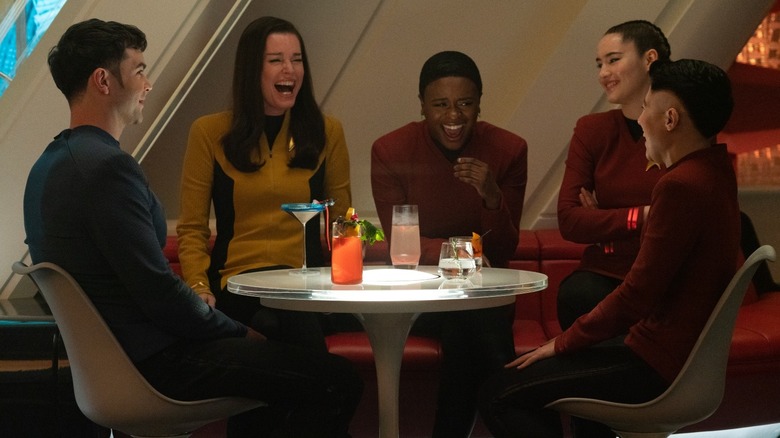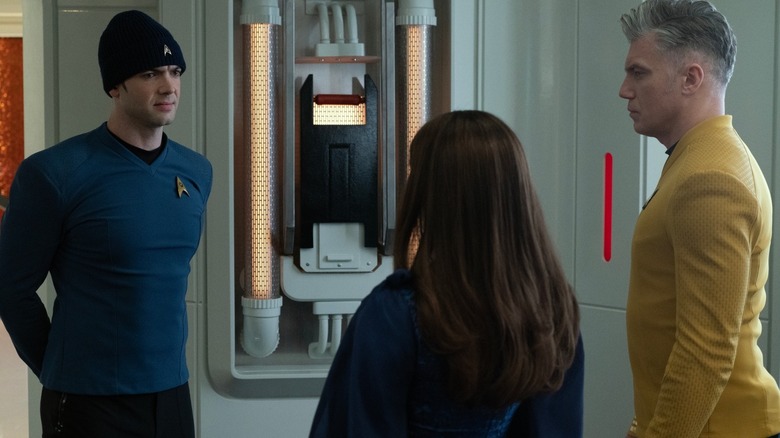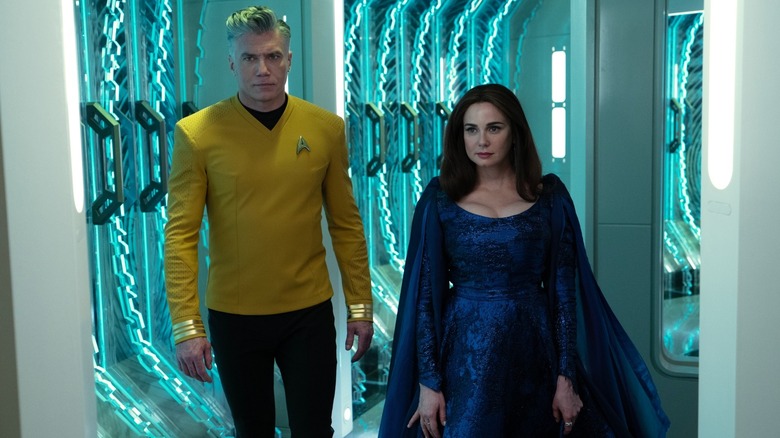Star Trek: Strange New Worlds Gives Directors The Freedom To Shift Between Genres [Exclusive]
One might credit the impressive longevity of "Star Trek" to its versatility. Overall, "Star Trek" is a science-fiction workplace drama, of course, but within that formalist, space-bound framework, it can incorporate any number of moods, stories, tones, and genres. The earliest episodes of the original series tended toward horror, with multiple monsters and demigods doing horrible things to the Enterprise and its crew. Later episodes involved military episodes about tactics and warship maneuvers. Others were light fantasy episodes about meeting fictional creatures manifested in real life. There were legal dramas, cosmic philosophy episodes, love stories, and even outright comedies.
While the thirteen extant "Star Trek" movies have largely been action films, on the small screen, "Star Trek" stretches every which way.
The most recent episode of "Star Trek: Strange New Worlds," called "Charades," is a comedy episode writ large. Thanks to an eerie alien medical procedure, Spock (Ethan Peck) was transformed from a half-human-half-Vulcan into a full human. With the transformation came a puberty-like wave of irrational emotions. Spock became ravenously hungry, constantly horny, and unable to control his feelings. By coincidence, Spock's transformation occurred right before his fiancée's parents were scheduled to visit the Enterprise. Can Spock hide his transformation from his ultra-Vulcan in-laws-to-be? This is the premise of a sitcom, or perhaps Mike Nichols' film "The Birdcage."
In an upcoming interview with /Film's Jacob Hall, Jordan Canning, the director of "Charades," talks about Trek's long-held genre versatility, and how "Strange New Worlds" in particular affords its makers a great deal of leeway when it comes to tone and creativity.
Directing comedy
Hall noticed Canning's canny ability to wring "Charades" for every available drop of comedy. While the timing of the dialogue and Ethan Peck's ability to mug and overact were key, it was also vitally important to have the episode's supporting cast constantly doing whimsical things in the background. To that observation, Canning responded:
"This was such an awesome exercise in exactly what you just said in terms of finding visual ways to find more humor, either in terms of reactions or little moments of blocking that weren't necessarily scripted. And also in terms of the comedic framing ... One of the many things that's so great about 'Strange New Worlds' is that they really do give their directors a lot of freedom to play within the stylistic world of the tone of the episode."
Canning allowed herself and her cinematographer to stray from the planned shot list and improvise more comedic shots during filming. She recalled one shot in particular of Spock on the bridge being taught how to behave like a Vulcan by the rest of the crew. That ended up being something Canning visually repeated, to comedic effect, throughout the episode.
"So you can switch up the kind of shooting style based on it being a comedy, or a horror, or a musical, or whatever it's going to be. We — the director of photography, Glenn Keenan, and I — I had storyboarded all the VFX sequences and had shot-listed, but as we started shooting, this really nice motif started to form of behind the head of Spock, these really nice symmetrical framing, centering Spock over to other characters looking back at him."
This motif, Canning said, put the audience "in the head" of Spock, so it was visually thematic as well.
The ability to stretch within the framework
Canning also talked about how "Charades" contained multiple montages, which she said she loves. Montages, while typically a lot of work, can communicate a lot of information and character development in a short amount of time. "Charades" starts with a montage of Spock at work, experiencing small workplace inconveniences. The montage is then repeated later in the episode when Spock is human, and the same workplace inconveniences now elicit different reactions. As a Vulcan, Spock patiently cleans up the breakfast detritus left behind by Sam Kirk (Dan Jeannotte). As a human, Spock yells at him.
Canning said of the parallel montages:
"All of those shots are mirrored so that you can really feel the change in him from sitting there very rigidly, to laughing uproariously and chugging his drink, or freaking out at Sam Kirk. We really lean into that. And it's fun when you ... I didn't go into it planning all of that out. I knew I wanted the montages to be mirrored, and things like that, but that sort of comedic framing really came about organically as we were shooting it, which [is] so much fun. You can plan everything to death, and then there's always fun surprises on set that inspire you and get to follow those threads."
While "Star Trek" may come from a 57-year tradition and the genres are still codified, there is still a lot of creativity within the framework. It sounds like Canning was elated to find those creative spaces.
"Star Trek: Strange New Worlds" season 2 is streaming on Paramount+.


